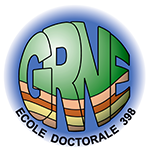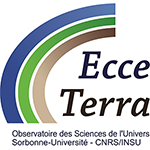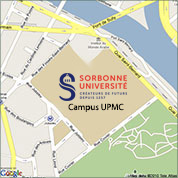Séminaire ISTeP - Armel Menant
(IPGP)
Toward an integrated vision of tectonic underplating in subduction zones
Study of now-exhumed ancient subduction zones revealed km-scale tectonic units of marine sediments and oceanic crust, which have been tectonically underplated (i.e. basally accreted) to the overriding plate at more than 10-km depth. However, geophysical observations of this deep process in active subduction zones (e.g. SW-Japan, Cascadia, Chile) are unclear and the dynamics, as well as the existence, of tectonic underplating along most of active margins remain controversial.
Using high-resolution visco-elasto-plastic thermo-mechanical models, we present with unprecedented details the dynamics of formation, preservation and destruction of underplated crustal nappes at 10-40-km depth in subductions zones. Thus, we are able to characterize tectonic underplating from the plate interface where tectonic slicing is triggered, to the surface where topographic variations may be expected in response to such huge mass transfers.
Our results show that subduction segments exhibiting an increasing frictional behaviour controls deep accretionary dynamics and that the long-term frictional zonation of the plate interface is stable due to a positive feedback between fluid distribution and effective stress. As a result, successive underplating events can be maintained during tens of Myr, leading to the formation of a high coastal relief. The rise of this relief is cadenced by an uplift-then-subsidence cycle, which characterizes each underplating event and the subsequent period of wedge re-equilibration. This periodical evolution is significantly modified by changing the rheological properties of the material entering the subduction zone, suggesting that tectonic underplating is likely a transient process active along most of active margins, depending on severe variations of the hydro-mechanical properties of the plate interface at Myr timescale.
25/01/2019, Salle Fourcade à 12h30
Egalement dans la rubrique
- Séminaire ISTeP - Bellanger et Hermant
- Séminaire ISTeP - Guillaume Le Hir
- Séminaire ISTeP - Nicolas Grasseau
- Séminaire ISTeP - Isabelle Moretti
- Séminaire ISTeP - Jean-Arthur Olive
- Séminaire ISTeP - Louise Jeandet
- Séminaire ISTeP - Hugues Raimbourg
- Séminaire ISTeP - Baptiste Rousset
- Séminaire ISTeP - Lucile Bruhat
- Séminaire ISTeP - Alfonso Mucci
- Séminaire ISTeP - Anthony Jourdon
- Séminaire ISTeP - Marianne Conin
- Séminaire ISTeP - David Pyle
- Séminaire ISTeP - Vincent Strak
Chiffres clés (Mars 2025)
L'ISTeP comprend 131 membres dont :
Permanents (66)
- Professeurs : 17 (+2 PAST)
- Maîtres de conférence : 26
- Directeurs de recherche CNRS : 1
- Chargés de recherche CNRS : 1
- ITA : 19
Personnels non permanents (65)
- Collaborateurs bénévoles / émérites : 17
- Chaire de professeur junior : 1
- Enseignants-chercheurs contractuel : 2
- 1 MCF accueil en délégation
- ATER et Post-Docs : 9
- Doctorants : 32
- ITA-BIATSS : 3





